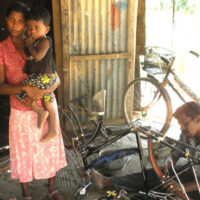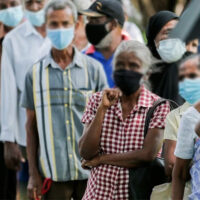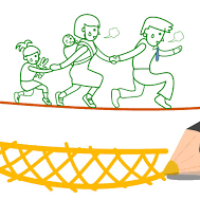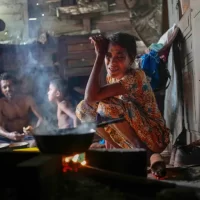Income Distribution Trends: World Vs. Sri Lanka
Dilshani Ranawaka and Hemesiri Kotagama
TIER – The Inequality Report
The Sri Lankan economic crisis is an opportune time to reflect and reset our social contract, i.e., agreement on social-political-economic rules of behavior amongst people and with government.
Distributive Justice
Amongst the multidimensional expectations of sustainable development of a nation, the most fundamental expectations include achieving economic efficiency and distributive justice. Society’s perception of how fairly or justly ‘rewards’ and ‘costs’ are shared or distributed among society’s individuals belonging to different sections (such as gender, ethnic groups, geographic regions etc.) is distributive justice. ‘Rewards’ would denote those such as national income, ownership of resources, provision of public goods and services as health, education. ‘Costs’ are those associated with the current economic crisis in Sri Lanka.
Society’s craving for distributive justice has influenced radicalism in the social-political arena of Sri Lanka, leading to spikes and continuity over decades of social upheaval.
In layman’s parlance the social expectation on efficiency and equity is: “to make the cake as big as possible (efficiency) and share it fairly (equity)”. The expectation on efficiency (as growth in national income) is rather clear and easy to agree upon as “more is better”.
However, agreeing on expectations on equity (sharing of the national income and wealth) is rather daunting. Hence being socially informed, of aspects of distributive justice (in this article income distribution) would lead to public discussion, which in turn lead to harmonious agreement, on expectations on distributive justice. This writing attempts to compare world income distribution experience and trends with that of Sri Lanka.
Beyond the human instinct that seemingly crave for income equality, empirical studies have proven that the nature of income (wealth too) distribution does have an impact on economic growth, society’s access to food, health and education etc.
Kuznet’s Theory
The above theory has proved that as a country’s income grows, income distribution becomes unequal and after a certain level of economic growth, the income distribution becomes more equal. The quality of life in a society also depends on the nature of income distribution. In a society with a highly unequal income distribution the few rich will dominate the economy and political power. The few rich that have higher purchasing power will determine what would be available in the markets and at what price. The majority poor would be bullied to accept what is available in the markets at higher prices. The majority poor will be curtailed in access to food, shelter, clothing, education and health services etc.
There are several quantitative indicators to measure income distribution. The Gini-coefficient is the most commonly used indicator. The Gini-coefficient ranges from 0-1 (could also be expressed as a percentage) and 1 indicates perfect inequality of one person receiving all the income and 0 indicates perfect equality. Thus lower the Gini-coefficient more equal is the income distribution. There isn’t a definite optimal socially agreed income distribution (a Gini-coefficient) to achieve. Less inequality is commonly considered to be better. However, some believe some inequality is inevitable and even necessary for economic growth. The optimal income distribution is socially decided through political institutions and its achievement is influenced through social and economic policy of governments.
Given below (Figure 1) is a comparison of trends in the changes of world and Sri Lankan Gini-coefficients (thus income distribution) over time.

Figure 1. Trends in change of income distribution: World vs Sri Lanka
Data Source: World Inequality Data Base (https://wid.world/data/)
It’s observed that Sri Lanka has a lower inequality than the world average, however the world average is declining, and Sri Lanka’s income inequality is stagnating. The welfare state that Sri Lanka has maintained since national independence in 1948 may be the main reason for this achievement. Food and agricultural subsidies, free access to health and education, implementation of many government pro-poor support programs (Janasaviya, Samurdhi, Gam-Udawa etc.) have provided opportunities for the poor. Through investments on new schemes, and rehabilitation of existing irrigation systems and resettlement schemes the landless poor have been provided with opportunities for farming. Land reform programs that were implemented during the 1970’s which instituted a ceiling on land ownership, securing land tenancy to tenants etc., are drastic policies that influenced pro-poor income distribution. Targeted creation of jobs for the rural poor such as the garment industry too may have had impact to reduce income inequality. Empirical research is yet to be done to establish the factors that have influenced income distribution in Sri Lanka.
It is observed that both the world and Sri Lanka’s trend on income inequality has initially worsened since 1980s. The 1980 was the era of globalization and Sri Lanka to adopted very clearly, a market led open economic system since 1977. Empirical literature suggest that globalization was a main cause that led to growing income inequalities, in the early period of globalization and this may have been the case in Sri Lanka too.
It is then observed that, since year 2000 the income distribution has turned to be more equal over years, as theorized by Kuznet’s theory (considering that world and Sri Lankan income has grown over years). Thus, Sri Lanka has shown a satisfying trend towards more equal income distribution in the past. Since 2010 the change in income distribution has stagnated. Currently the economic crisis would have worsened income distribution leading to widening the gap between the rich and the poor and reducing better opportunities, freedom choice and unrest for some groups. Hence it is imperative to consciously examine and be informed of changes in income distribution of Sri Lanka to halt it from worsening and to make it better than the past.
The TIER (The Inequality Report) is a flagship project undertaken by Centre for Poverty Analysis (CEPA) that analyzes the state, consequences and reasons of inequality in Sri Lanka and share its findings with the public.
Disclaimer: The views expressed in this article are those of the authors and do not necessarily reflect the views and policies of CEPA









